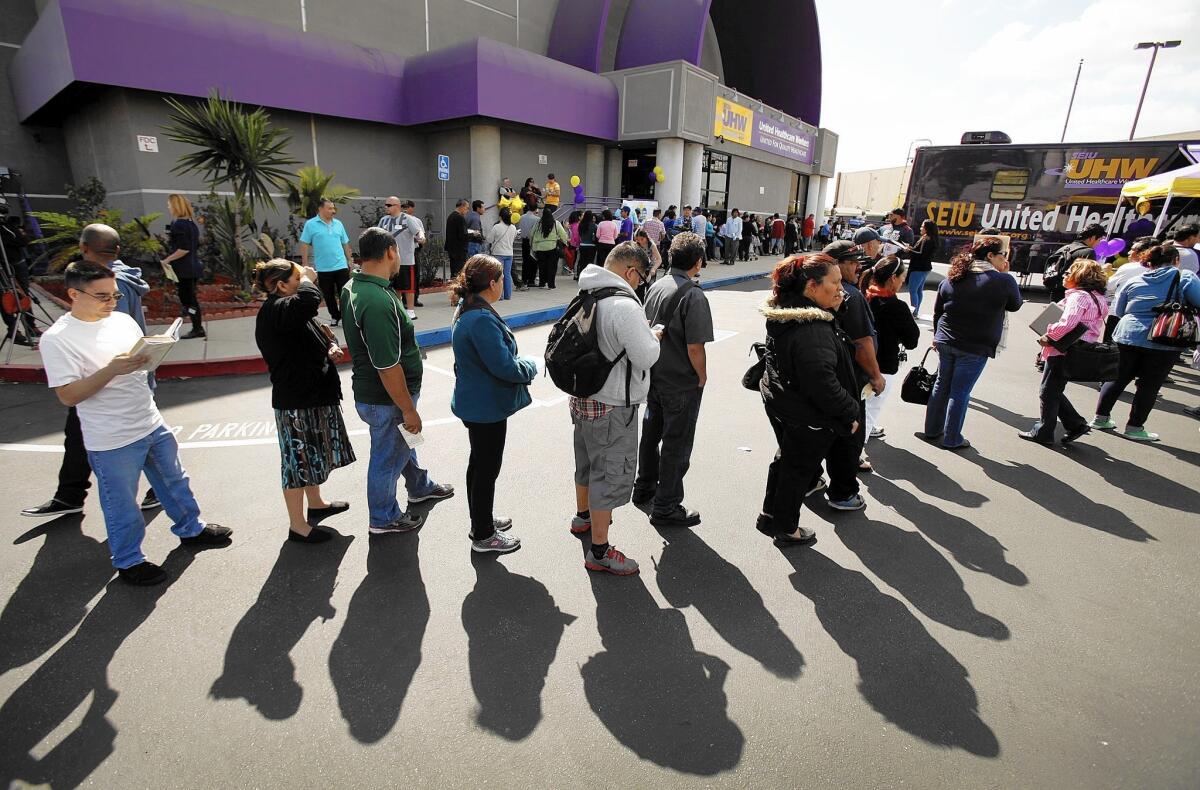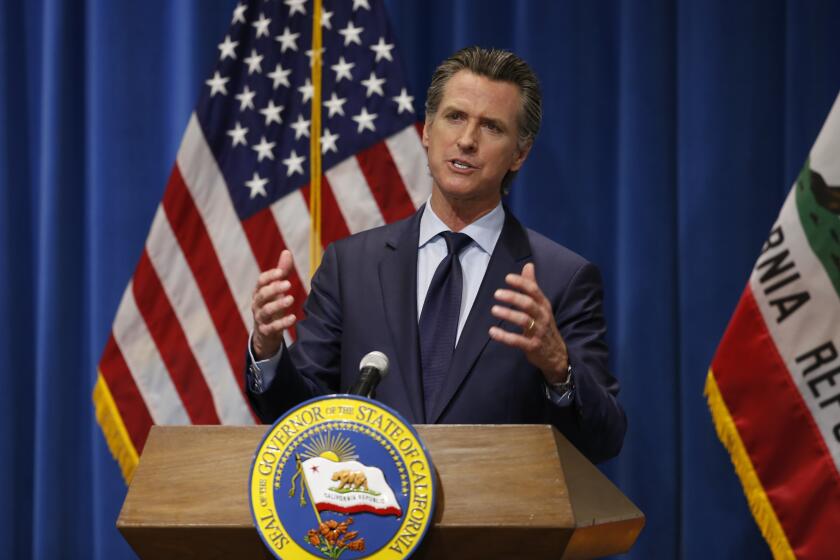Under Obamacare, Medi-Cal ballooned to cover 1 in 3 Californians

- Share via
California officials never anticipated how many people would sign up for state-run health insurance under Obamacare.
The state’s health plan for the poor, known as Medi-Cal, now covers 12.7 million people, 1 of every 3 Californians.
If Medi-Cal were a state of its own, it would be the nation’s seventh-biggest by population; its $91-billion budget would be the country’s fourth-largest, trailing only those of California, New York and Texas.
“When the final numbers started coming out, where a third of the population was on Medi-Cal, it went way past anyone’s expectations,” said state Sen. Ed Hernandez (D-West Covina), who chairs the Senate Health Committee.
Expanding Medi-Cal was a key part of the Affordable Care Act, the national law that overhauled the healthcare system and required nearly all Americans to have insurance starting in 2014. Under the law, Medi-Cal — historically a health program for poor families and the disabled — was opened to all low-income Californians starting two years ago, with the federal government paying for those new enrollments.
Though a surprise, the high Medi-Cal enrollment is generally hailed as a success. California’s uninsured population has been cut in half since Obamacare, in large part because so many Californians signed up for Medi-Cal, which is free for beneficiaries.
“The Medi-Cal program continues to grow at a very substantial rate, which is great. We are very happy that we’re able to provide healthcare to getting close to 13 million Californians,” said Mari Cantwell, chief deputy director at the state Department of Health Care Services, at a hearing in downtown L.A. this month. But, Cantwell added: “Obviously with that comes cost.”
The question California officials now face is how — and on days with a gloomier economic outlook, if — the massive health program can be sustained. Already, Medi-Cal is seen by many as underfunded, with patients struggling to find doctors and sometimes receiving low quality of care. A group of activists and others recently filed a federal civil rights complaint alleging that Latinos are being denied access to healthcare because the program does not pay doctors enough.
In many ways, how the program fares will be an important test for the Affordable Care Act.
Join the conversation on Facebook >>
Medi-Cal is California’s version of Medicaid, a joint federal-state program that exists in every state and has historically provided free health coverage to those considered too poor to afford needed medical care.
With Medi-Cal, “a lot of people enrolled quickly and stayed in, and that’s a really big part of the ACA’s success,” said Sonya Schwartz, a research fellow at Georgetown University Health Policy Institute’s Center for Children and Families.
The Affordable Care Act allowed states to open up Medicaid to anyone making less than 138% of the federal poverty level — for a single person, a couple or a four-person family, that means an annual income of less than $16,243, $21,983 and $33,465, respectively.
In California, officials predicted that fewer than 1.5 million people would have enrolled by now. Instead, more than 4 million Californians have signed up.
Sara Hayden, 52, joined Medi-Cal in early 2014. She has rheumatoid arthritis and other diseases that require expensive medicines and frequent doctor visits.
“It’s just been a godsend for me,” said Hayden, who lives in Half Moon Bay near San Francisco. She is unemployed and can’t afford private insurance.
The record number of people like Hayden who have signed up led to big cost increases for the program. Its price tag has jumped from $59 billion to $91 billion.
The program’s enrollment probably will continue to swell, though at a much slower pace, as healthcare prices keep growing nationwide.
“I’m certain we’re going to get close to cracking that $100-billion budget for the Medi-Cal,” Cantwell said.
The federal government promised to initially pay costs of enrollees newly eligible under Obamacare. So while the federal government’s annual Medi-Cal payments have increased by $28 billion since 2013, the state’s have gone up less than $4 billion.
Starting in 2017, however, the state will be required to chip in more. Instead of the federal government paying 100% for newly eligible enrollees, the state will have to begin paying 5%. By 2020, the state will be paying 10% of the costs.
However, experts say that is a relatively small increase.
“That’s a really great deal for California,” said Scott Graves, research director at the California Budget & Policy Center. “You don’t find that anywhere else.”
Advocates say the expansion, with the huge infusion of federal money, should in fact eventually yield savings for states, possibly enough to make up for the costs.
UC researchers calculated that each new federal dollar brought to California by Medi-Cal will generate 5.4 cents in tax revenue for the state, which would mean several billion dollars. That’s because the money creates jobs in healthcare, which creates income and sales tax.
Experts predict other savings as well. Medi-Cal can be a boon to the personal finances of Californians who previously went without insurance or struggled to pay for it.
Before signing up for Medi-Cal, Hayden, who can’t work because of her illnesses, was quickly draining her bank account by paying a $900 monthly premium for private insurance.
“I have depleted my savings, my 401(k),” she said. Since joining Medi-Cal, she hasn’t paid a penny.
Many experts also say the state will save money on services that can now be accessed through Medi-Cal, such as mental health services and substance abuse treatment.
Plus, many ongoing efforts to improve care for patients are also intended to lower costs, said Chris Perrone with the California HealthCare Foundation. A big one is moving all Medi-Cal beneficiaries onto managed care, a system to better coordinate medical care, with the intent of reducing overlap, delays and costs.
However, with so many new initiatives, it’s difficult to determine the financial effects of the expansion on the state because savings can be realized in several different departments, and may not be caused by Medi-Cal, experts say.
Also watching are the 20 mostly Republican-led states that didn’t open up their Medicaid programs. Advocates there hope that seeing savings in states that did expand will encourage their legislators to follow suit.
In California, state officials are discussing how they’ll afford the program next year. Gov. Jerry Brown called a special legislative session this year to address funding for Medi-Cal.
“It’s a strained system,” said Hernandez, “and I really believe we need to figure out how to resolve this because we need to make sure that these people have access to care.”
Follow @skarlamangla on Twitter for more health news.
ALSO
Higher pay, hoverboards and vaccinations: Hundreds of new laws in California
Sex-crime charge marks a turning point in the Bill Cosby saga
Texas ‘affluenza’ teen is fighting deportation from Mexico; mother arrives in L.A.
More to Read
Sign up for Essential California
The most important California stories and recommendations in your inbox every morning.
You may occasionally receive promotional content from the Los Angeles Times.











